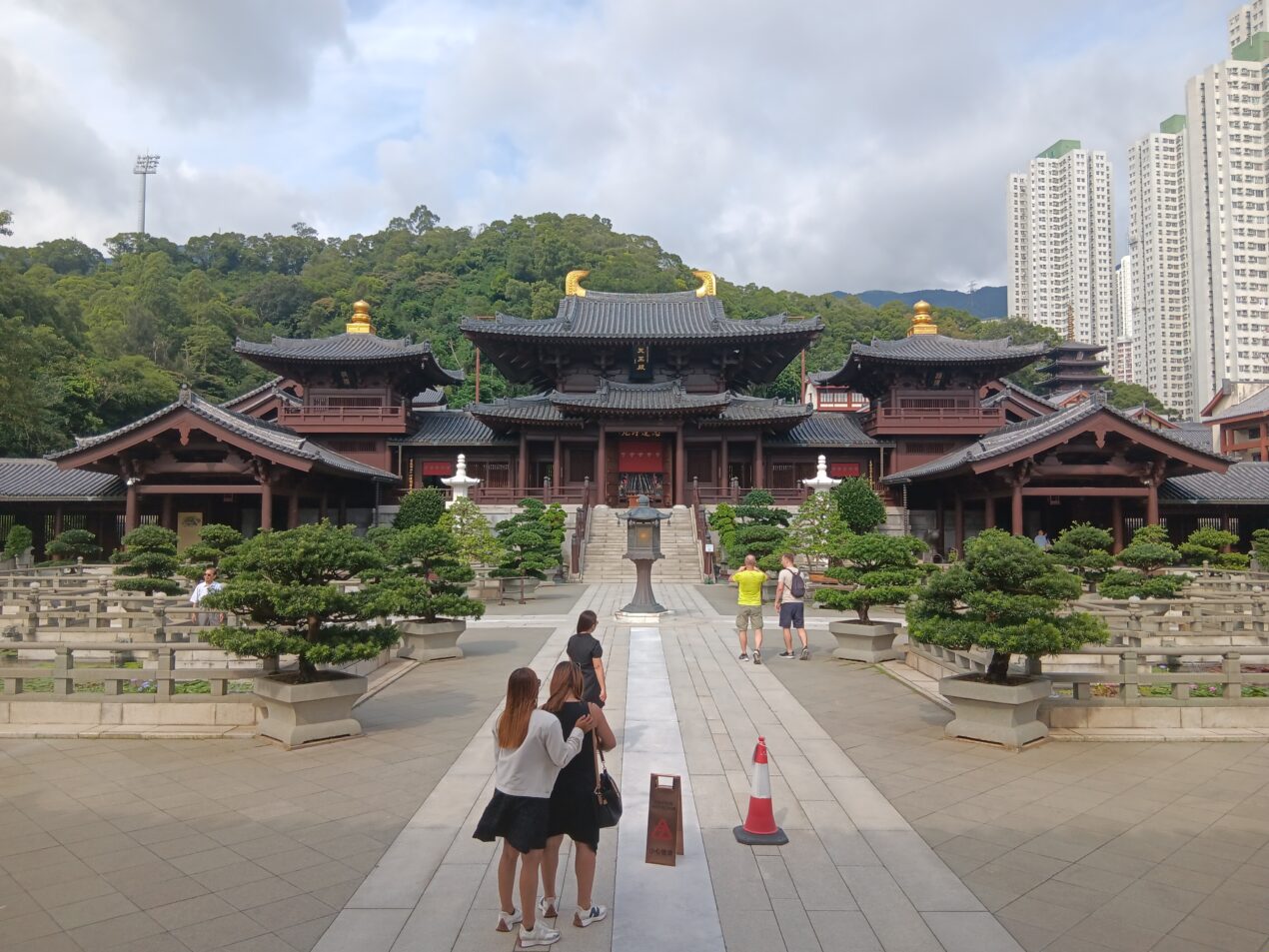Why Nan Lian Garden & Chi Lin Nunnery Need to Be on Your Hong Kong Bucket List
If you read my recent post about eating at the popular Singaporean-originated Shanghainese chain ‘Paradise Dynasty’ in Kai Tak the other week with my Old Man, then you already know that it was one of my favorite Hong Kong days ever.
And that’s because it wasn’t just any typical lunch. It was one with purpose.
That’s right. It was time to go be a tourist in my own city and revisit an area that honestly, I hadn’t stepped foot in since several years prior when I was still playing baseball and probably 15 kgs lighter – enter the iconic Chi Lin Nunnery and Nan Lian Garden in Diamond Hill.
Here’s why the Nan Lian Garden and Chi Lin Nunnery need to be on your Hong Kong bucket list…as of YESTERDAY!
How to Get to Chi Lin Nunnery & Nan Lian Garden
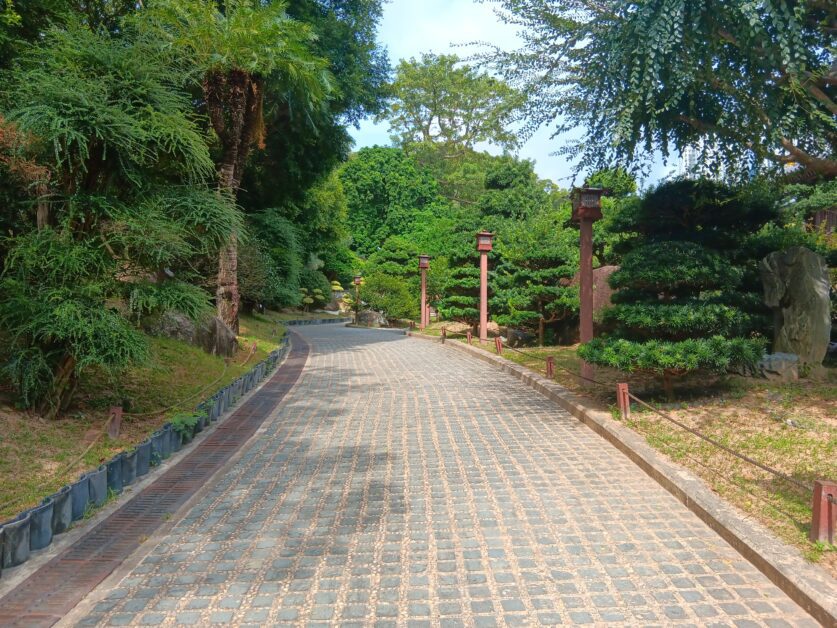
Website, Address, & Details: http://en.chilin.org/, https://www.lcsd.gov.hk/en/parks/nlg/index.html
- Location: Chi Lin Nunnery: Chi Lin Nunnery, 5 Chi Lin Dr, Sheung Yuen Leng, Nan Lian Garden: Fung Tak Rd, Diamond Hill
- Price: F-R-E-E. Temple Halls and the Nan Lian Garden are absolutely free and open to the public.
- Hours:
- Chi Lin Nunnery: 9:00 AM – 4:30 PM
- Nan Lian Garden: 7:00 AM – 9:00 PM
First, both Chi Lin Nunnery and Nan Lian Garden are part of the same complex. While they are distinct Tang-dynasty style attractions, they are connected by an overarching pedestrian footbridge and mere meters apart. Each simply feels like an extension of and/or intertwined with one another.
So, when you’re getting to one of these attractions, you’re also getting to the other.
The most straightforward way to visit both Chi Lin Nunnery and Nan Lian Garden is to take Hong Kong’s MTR to Diamond Hill. There are likely one of two ways that you’re coming from (this is specifically for tourists):
- From Central,
- From Tsim Sha Tsui (TST).
From the Central MTR Station, take the Tsuen Wan Line (Red Line) north (towards Tsuen Wan) to Mongkok. Transfer to the Kwun Tong Line (Green Line) to Tiu Keng Leng and get off at the Diamond Hill MTR Station. In total, it should take you no more than 30 to 35 minutes.
From Tsim Sha Tsui Station, it’s even quicker and more straightforward to get to Diamond Hill. You also have two routes you can choose from.
The first is to simply hop on the Tsuen Wan Line, transfer at Mongkok to the Kwun Tong Line, and ride it to Diamond Hill (the same route from Central).
The second is to walk from Tsim Sha Tsui Station to East Tsim Sha Tsui Station. You can do this by following the signs once you enter the Tsim Sha Tsui MTR. Once you get to East Tsim Sha Tsui, take the Tuen Ma Line (Brown Line) north. There’s only one direction it heads from here. The Tuen Ma Line will take you directly to Diamond Hill.
My only point of note about those thinking that the Tuen Ma Line may be the quickest route (because Google says so), understand that the walk from Tsim Sha Tsui Station to East Tsim Sha Tsui Station isn’t just a quick walk and is deceivingly longer than Google Maps leads on (in my humble opinion).
Either way, it should take you roughly 20 to 25 minutes to get to Diamond Hill from Tsim Sha Tsui.
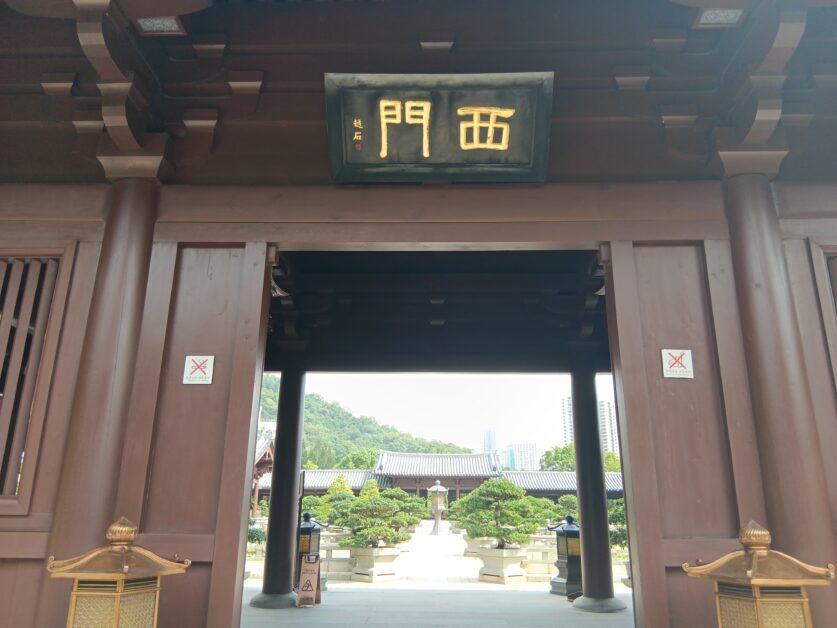
Both lines drop you off smack-dab in the center of Plaza Hollywood, Diamond Hill’s nearly 30-year-old shopping mall that was styled after, you guessed it, Hollywood.
Take Exit C1 or C2. You’ll come out less than a 5-minute walk from both. Follow Sheung Yuen Street until it meets Fung Tak Road. Turn right onto Fung Tak Road and walk for several minutes. Chi Lin Nunnery will be on your left and Nan Lian Garden will be on your right.
Personally, I prefer to spend more time in Nan Lian Garden so I always begin my journey here by peeling left into Chi Lin Nunnery and then crossing over the pedestrian bridge to Nan Lian Garden once finished.
Honestly, I do NOT recommend taking the bus (or minibus) as this will nearly double the time spent to get there.
Pale Ale Travel Note: If you have carved out a reasonable bus route to get from Central and/or TST to Diamond Hill, let me know in the comments and I’ll be happy to update the article!
What I Love About Nan Lian Garden & Chi Lin Nunnery
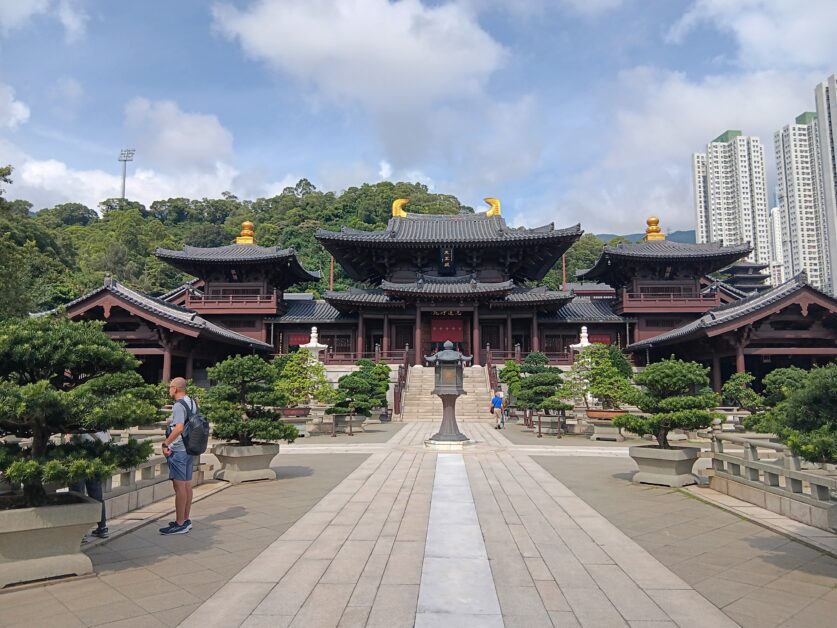
When it comes to quintessential, iconic sites in Hong Kong, name a better combo than both Chi Lin Nunnery and Nan Lian Garden. I’ll wait.
Both also happen to be two of the most underrated spots to visit when exploring the city. Hence, why I’m writing this ode celebrating them.
Pale Ale Travel Tip: My goal is to help you explore the “Hong Kong” which most people don’t get to see. One of my most recent and favorite posts on the site breaks down my top hikes in the city. Not only are these all fantastic workouts and a great way to burn off the previous night’s beers but they are also one of the best ways to explore Hong Kong. Here are 9 of the best hikes in Hong Kong for mountaineers of all skill levels.
Chi Lin Nunnery: a Tang Dynasty Style Wooden Marvel
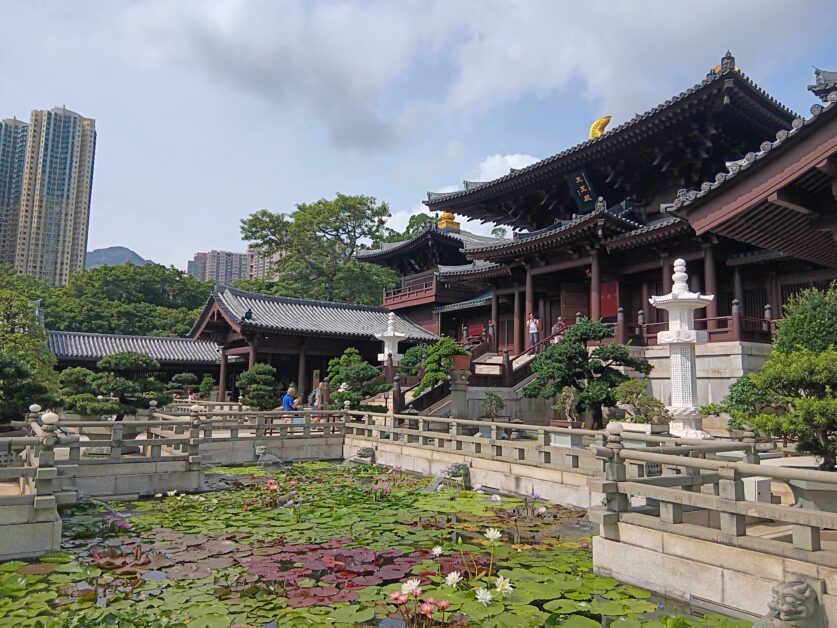
“Nun today, nun tomorrow.”
Built as a retreat for Buddhist nuns in the mid-1930s, Chi Lin Nunnery is one of the few remaining and prominent testaments to Hong Kong’s dynamic blend of history, architecture, and spirituality.
After significant wear and tear, this expansive Buddhist complex was rebuilt in 1998 in traditional Tang dynast fashion to better preserve its historical and cultural legacy.
Most notably, the design was inspired and based on a Sukhavati drawing in the Mogao Caves (located in Gansu Province) – a UNESCO World Heritage Site well-known for its rich collection of Buddhist art (some dating back to the 4th century).
For those, like myself, fully unaware of the basic tenets of Mahayana Buddhism, the ‘Sukhavati’ is a ‘Pure Land’ envisioned by Buddhists after being reborn. Simply put, it’s a divine place of spirituality and promised enlightenment where one can fully train for Buddhahood that hasn’t been tainted by normal, non-religious, corrupt people like myself.
Rebuilt in line with this revered drawing, Chi Lin Nunnery’s new form sought to echo the tranquil, meditative, and sacred feeling of the ‘‘Pure Land’.
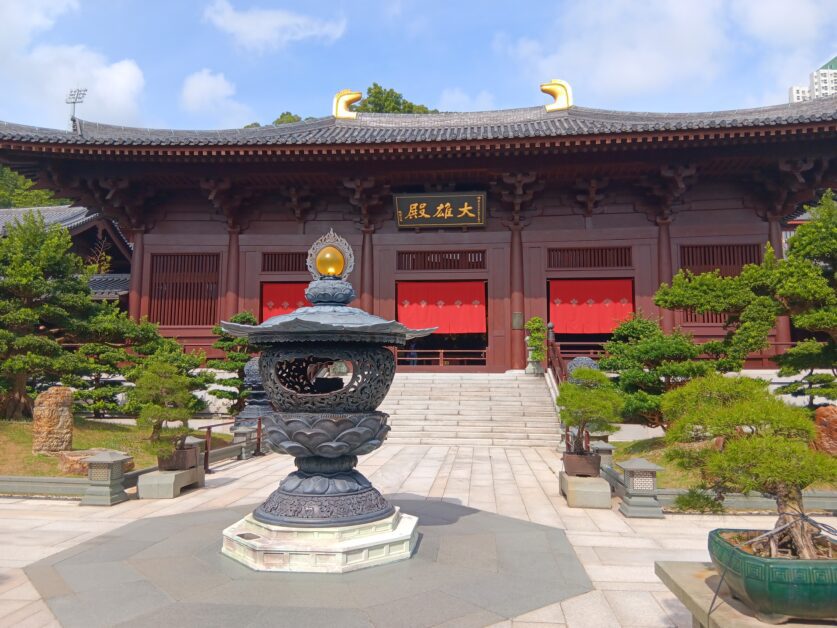
A 33,000 square meter complex, the nunnery is comprised of three courtyards (the main courtyard, inner courtyard, and open courtyard), and teeming with lotus ponds, pavilions, bonsai trees, 16 wooden halls, tiered roofs, and interlocking wooden compartments, along with gold, clay, wood, and stone statues of the Sakyamuni Buddha (aka ‘Siddhartha’), the female goddess of mercy and bodhisattva Guanyin, and various other bodhisattvas (those on the path towards Buddhahood and enlightenment).
It includes a library, a school, a pagoda, a bell tower, and a drum tower as well.
The complex, true to the ancient Chinese art of Feng Shui, is propitiously angled, facing the water, inviting prosperity and abundance for those visiting. One of Hong Kong’s most celebrated mountains (and peaks), at the heart of a revolution and covered in 140 million year old granite, Lion Rock, its signature lion’s head overlooking it all.
What’s especially noteworthy and particular to the Chi Lin Nunnery and its adherence to authentic Tang dynasty style architecture is that it was constructed entirely with cypress wood, a highly durable and element-resistant wood found in Asia, Europe, and North America.
Currently, it’s the largest hand-made wooden building in the world.
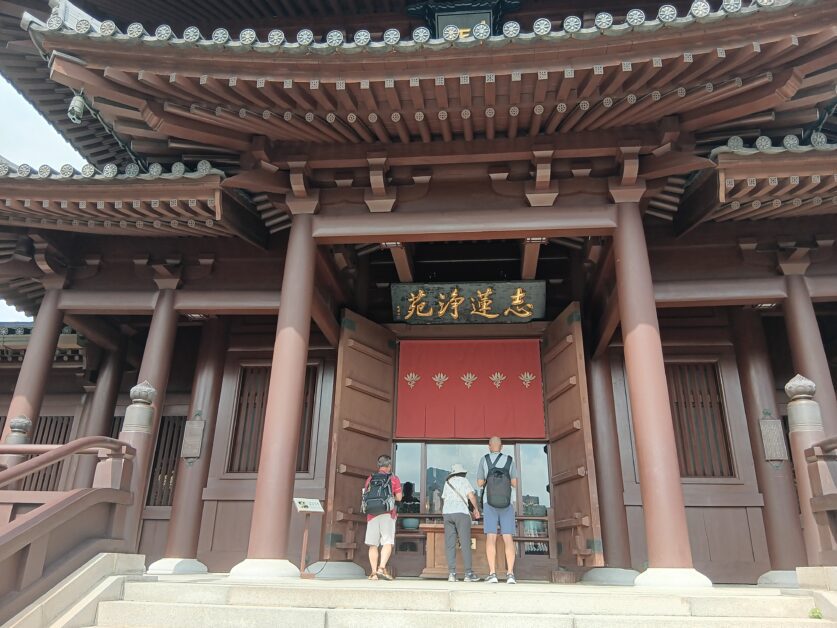
It was also constructed without the use of a single nail. That’s right. It stands firm thanks to a series of special interlocking systems cut into the cypress wood.
In 2018, the Chi Lin Nunnery received a second makeover, thanks to a lighting project and initiative aimed at enhancing the tranquil and spiritual atmosphere of the complex, particularly during nighttime, with the installation of small spotlights and LED strips on the ground, stairs, and roof.
Today, Chi Lin Nunnery houses over 60 nuns and is a residence for elderly Hong Kongers.
Pale Ale Travel Note: Keep in mind that you aren’t allowed to take pictures in the main halls or of the Buddha and bodhisattva statues. I also recommend keeping your voice down out of respect for others who are there for active worship. Finally, don’t show up in your finest cut-off jean shorts and Van Halen t-shirt, dress appropriately. Make sure to respect this!
My Chi Lin Nunnery Highlights
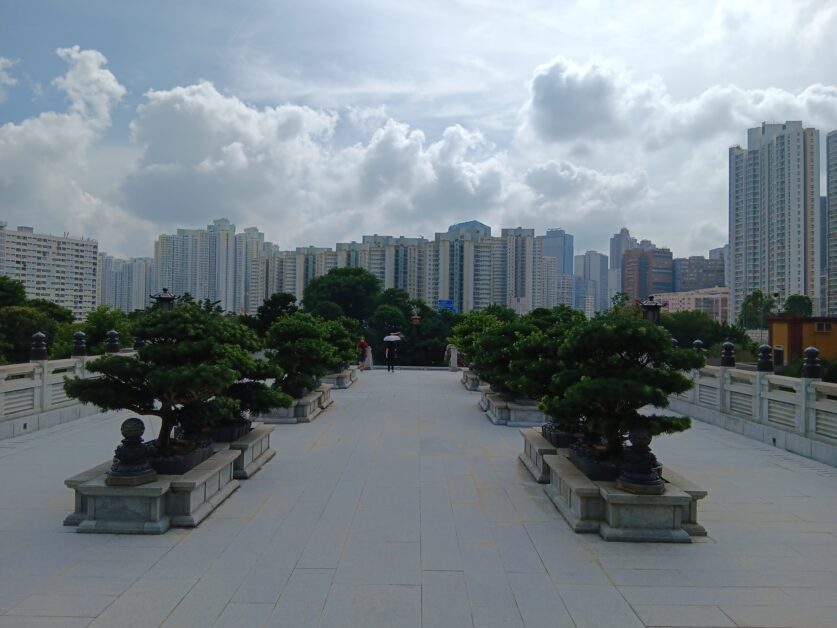
The Chi Lin Nunnery’s 1998 wooden rebirth was deliberate in its complementary nature to the adjacent Nan Lian Garden, built as a serene counterbalance to the surrounding urban landscape.
Rich wooden paneling with red and white curtains, gold Chinese lettering above hall entrances, and quirky yet artistic (bright) bonsai trees and rectangular lotus ponds boasting several shades of leaves, all with the backdrop of plain Choi Hung and Diamond Hill skyscrapers in the background – there aren’t quite as stark of contrasts in the city between spirituality and the concrete jungle (where dreams are made of) like there are when you step into the nunnery.
This applies to Nan Lian Garden as well and becomes most evident when you make your way across the pedestrian overpass and walkway lined with bonsai trees firmly planted in stone bases and are confronted with panoramic views of the surrounding apartment buildings.
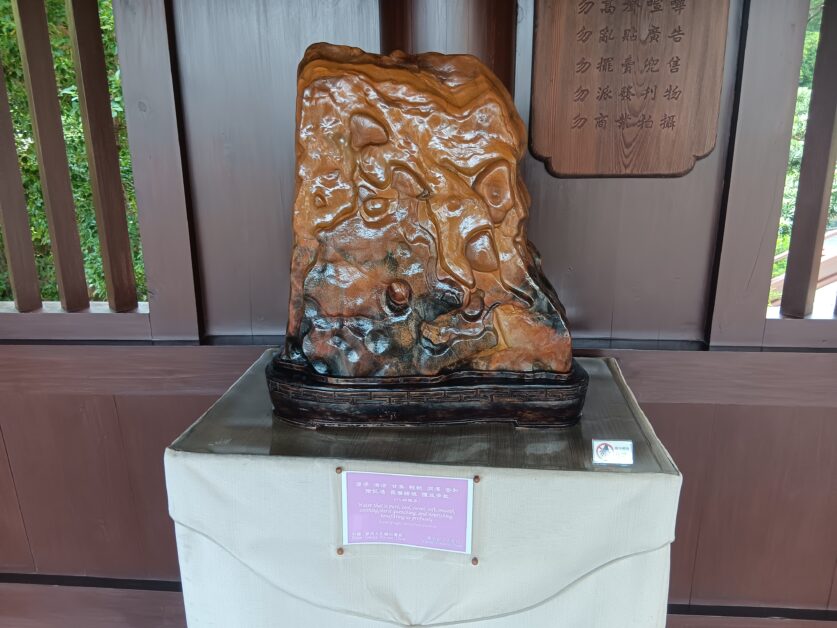
The contrast between cutthroat consumer capitalism and cookie-cutter high-rise buildings becomes even more evident after you get your first glimpse of the bright golden Buddha and bodhisattvas in the main hall, perched on a wooden table and surrounded by bouquets in bronze vases, bonsai trees, and fruit.
There’s a required peace and calm that you have to enter into, voluntarily or involuntarily, when entering a main hall. It’s a slowing down of time that I don’t think most of us living in Hong Kong (or even those visiting) get to experience too often.
Pale Ale Travel Note: During my father and I’s most recent trip, the nunnery had a bonsai and fine stone exhibition just to the right when entering through the West Gate, which had me far more amped up on bonsai than I ever thought I’d be in my lifetime.
Joseph & the Amazing Technicolor Nan Lian Garden
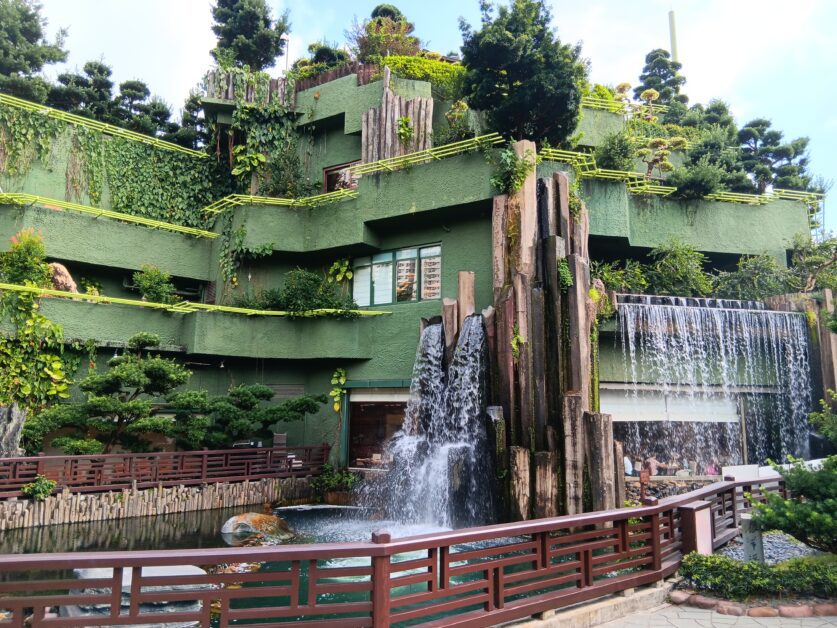
Make sure to stop in for a bite at Chi Lin Vegetarian!
Gun to my head, Nan Lian Garden is my favorite of the two sites in Hong Kong. But like a peanut butter and jelly sandwich, you can’t have one without the other.
A simple peanut butter sandwich or a couple of slices of bread with jam hastily spread in between doesn’t quite hit the same as the combo of the two. The Nan Lian Garden-Chi Lin Nunnery combo may be the ultimate one-two sightseeing punch in Hong Kong.
As mentioned above, this nearly 9-acre Chinese classical garden, and masterpiece of living floral art, unfolds as you cross the connecting pedestrian bridge from Chi Lin Nunnery.
Opened to the public in 2006, the Nan Lian Garden was designed as a complement to the nunnery and built in the same Tang dynasty style – in furtherance of serenity and the harmonious weaving of both nature and man-made structures.
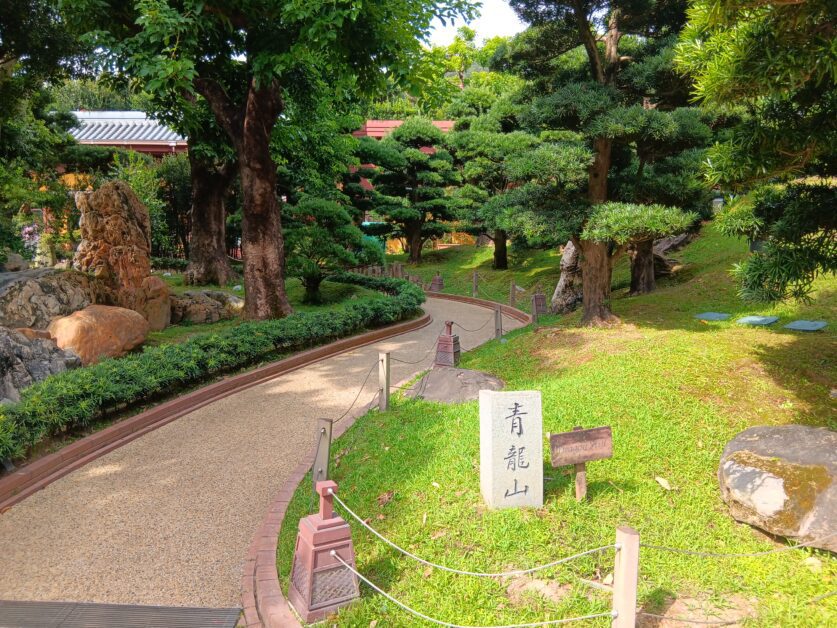
One thing that shaped how I view classical Chinese gardens and my rudimentary understanding of how they are designed is that they are meant to act as a miniature idealized landscape of both man and nature.
So, expect a meticulous integration of natural elements like water, rock works, flora, and trees, with human artistic expression and craftsmanship, like calligraphy, architecture, sculpting, and gardening.
It’s a non-linear journey, unlike Baroque and Renaissance-style European gardens and parks, which often boast open, expansive lawns and highly visual pathways leading to a central focal fixture, meant to reflect man’s control over nature.
Chinese classical gardens, like Nan Lian Garden, are rooted in Buddhist, Daoist, and Confucian philosophies that strive to symbolize humankind’s harmony with nature. This manifests itself through what feels to be more of our reality, a more organic coexistence of asymmetry, spontaneity, and unpredictability.
Think winding pathways that unravel new surprises as you turn each corner, varied elevation, secluded corners, natural-looking ponds and waterflow, jagged rocks and rockeries, and an inability to view the garden in its entirety.
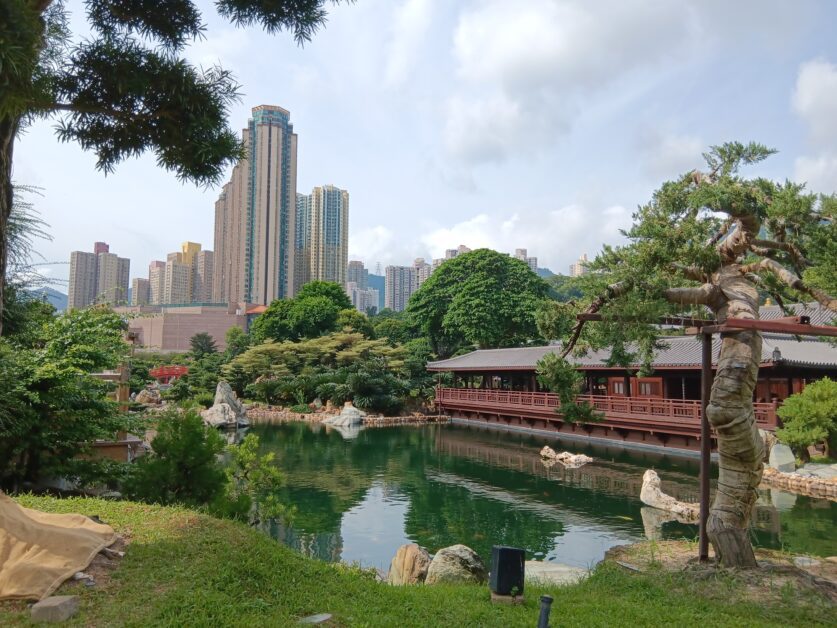
It piques the explorer in you and requires you to approach your stroll from multiple perspectives. The human-made pavilions, bridges, and corridors act as a conduit that merges (and emerges from) with the garden, offering framed Shisha Odashi and Black Mamba vibes (Kill Bill reference) from specific points.
To me, the biggest difference between the two is that the sprawling, well-delineated European gardens I’ve visited invoke more of an awe-inspiring admiration for mankind’s taming of nature, while Chinese classical gardens yield introspective, tranquil, and emotionally engaging feelings that force you to contemplate your existence with the natural world.
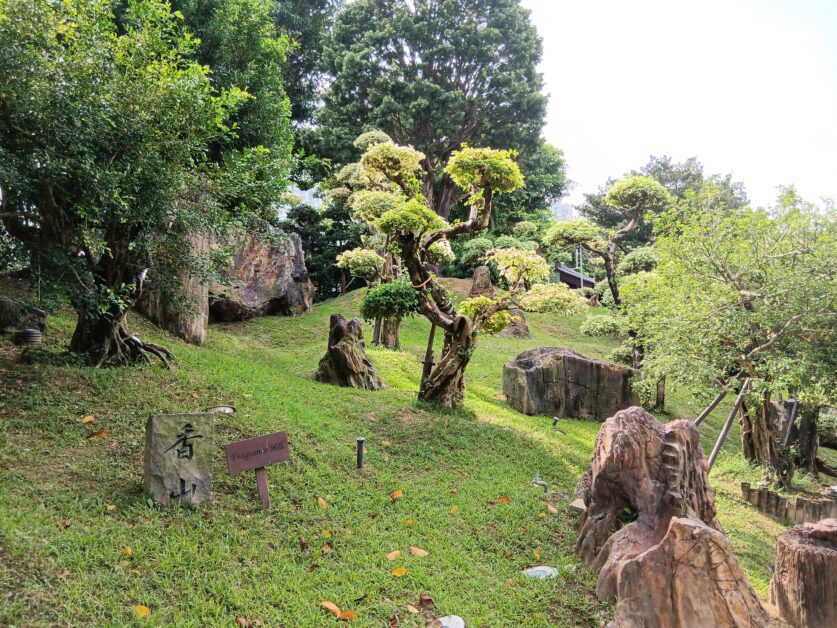
After weaving your way in and out of the connected pathways, past the deliberately arranged rock formations and functional wooden-beamed building (aka ‘The Rockery’) home to an extensive collection of exquisitely shaped sedimentary rocks of all sizes in raked gravel, soothing, cascading ‘Long Man Lou waterfall’ that hides the beloved ‘Chi Lin Vegetarian’ restaurant (and tea house), and turquoise ‘Blue Pond’, flush with leisurely swimming orange and yellow Koi, the garden opens up to reveal its crowning site – the Pavilion of Absolute Perfection.
I’m not sure there has ever been such a bold name that actually delivers on all fronts. The Pavilion of Absolute Perfection talks a big game AND backs it up. Visually, it is one of the most memorable sites for this Big Body in Hong Kong.

Connected to the ‘mainland’ via the curved, bright orange timber Zi Wu Bridge, a striking golden pavilion shines through like a floral lighthouse, reflecting in the surrounding greenish blue pond, while playfully peering through manicured greenery, rock formations, and ornamental gating. This is why you came.
Like the Chi Lin Nunnery, the Pavilion of Absolute Perfection achieved absolute perfection via the same interlocking wooden framework (sans nails) in an homage to Tang-era building practices and architecture.
At one point, I thought I saw Bob Ross pop out from behind a bonsai tree with a brush, easel, and righteous afro, letting me know that no mistakes were made here, just happy little accidents thanks to the limited selection of colors that soothingly came together to form a rich, multi-layered, vivid landscape – one where each dimension seemed to perfectly blend into the next.
Pale Ale Travel Tip: You may have already seen me sing the praises of both of these places in a previous post. That’s right – it’s the perfect spot for couples. Make sure to check out my post breaking down the best date ideas in Hong Kong for couples who want to avoid being labeled as ‘the boring couple’.
My Nan Lian Garden Highlights
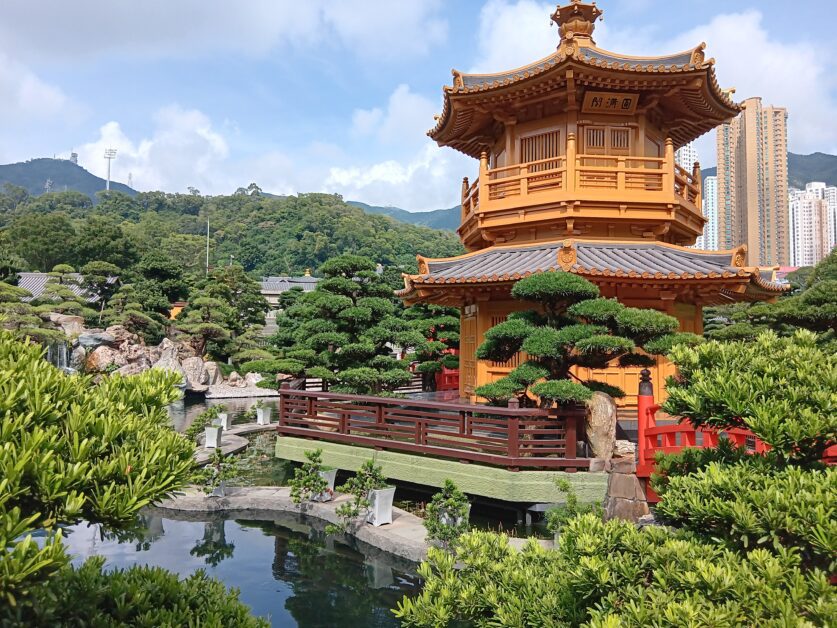
If I told you that the Pavilion of Absolute Perfection isn’t my favorite part of the Nan Lian Garden, I’d be lying.
What I especially love about it and the design of classical Chinese gardens is that as you make your way around this central, golden timber masterpiece, each angle highlights a unique view of its elegant design and setting – the surrounding bonsai trees, stones, and pond all hiding or revealing parts or melding with either the distant backdrop of Lion Rock or the surrounding apartment buildings to create an unforgettable panoramic portrait.
As someone who is always on the move and sometimes overly dogmatic and one-dimensional in his thinking, the asymmetrical layout and symbolism naturally cause you to shift perspectives and appreciate the varying framed amalgams of this golden pavilion.
I mean, just look at that.
I’m not just saying this because it’s truly one of the best pictures I’ve ever taken. Even what you’re seeing above doesn’t do it justice.

Next to the Pavilion of Absolute Perfection, the Chinese Timber Architecture Gallery low-key caught me off-guard with how much I enjoyed it due to its educational and cultural elements, acting as a contextual extension to the construction methods that made the entire complex possible.
If Nan Lian Garden is your first stop on your journey from Plaza Hollywood, the gallery will be one of the first things you see if you peel off left from the entrance.
It’s dedicated to showcasing the techniques, principles, and importance of Tang dynasty (and traditional) timber architecture with a series of scale models, detailed diagrams, and historical information about these building methods that have been passed down for centuries.
I wasn’t surprised that my father especially loved this portion of the garden as he’s a civil engineer, so I can only imagine what he was dreaming of when we parted ways that night.
Is Visiting Nan Lian Garden & Chi Lin Nunnery Worth It?
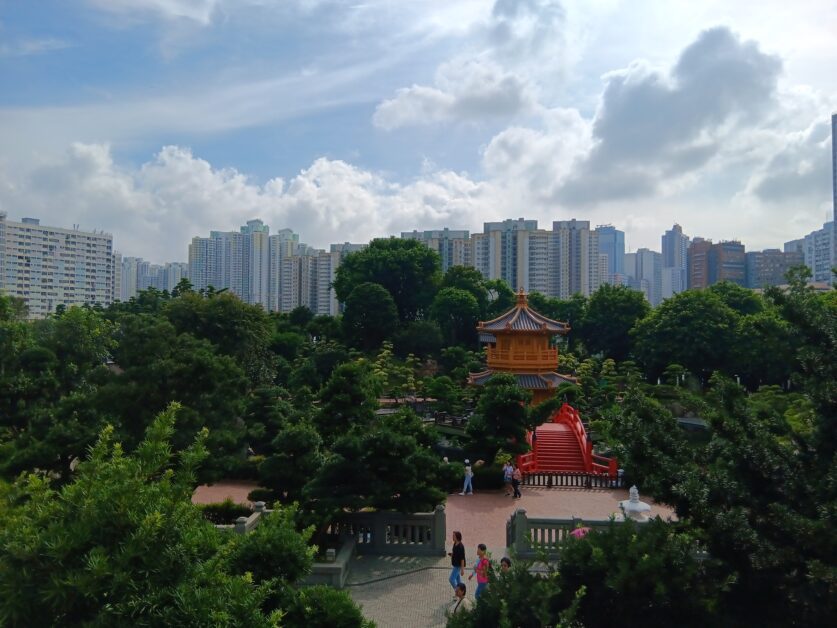
Absolutely. I firmly believe that both Chi Lin Nunnery and Nan Lian Garden are “slept-on” landmarks and attractions that often get overlooked in the course of a Hong Kong trip. They are emphatically worth visiting.
Understandably, both aren’t at the forefront of Hong Kong travel itineraries as Diamond Hill isn’t within the confines of the primary tourist areas of Central and Tsim Sha Tsui.
However, if you just exert that slight little extra bit of effort, you stand to open yourself up to a slice of Hong Kong that sheds light on its depth and multitudes and one that provides a much-needed reprieve from the in-your-face (and unavoidable) hustle and bustle of many pockets of the city.
And you know what? If the prose I wrote for this piece wasn’t convincing, just take a look at the pictures and then come and try and tell me that it isn’t a gorgeous complex and garden.
I guarantee that won’t happen.
If you have any questions about visiting Chi Lin Nunnery, Nan Lian Garden, or Hong Kong, please don’t hesitate to reach out to me and I’ll get back to you as soon as possible!
My email is info@palealetravel.com.
Travel well everyone,
Big Body
Big Body is a voracious lov…eater, a cowardly fighter, and a self-proclaimed curry goat BBQ-eating champion (don’t forget the donkey milk) who likes Stoicism, baseball, and writing in the third person. Having worked for himself for the last 7 years, he isn’t particularly successful but he does still drink ice-cold Sapporo draft beers with the best of them and knows his way around a Dai Pai Dong or two. He is based in Hong Kong but you can still find him in Saigon, Osaka, and Vienna for extended periods.
